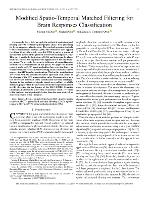Abstract
In this article, we apply the method of spatio-temporal filtering (STF) to electroencephalographic (EEG) data processing for brain responses classification. The method operates similarly to linear discriminant analysis (LDA) but contrary to most applied classifiers, it uses the whole recorded EEG signal as a source of information instead of the precisely selected brain responses, only.
This way it avoids the limitations of LDA and improves the classification accuracy. We emphasize the significance of the STF learning phase. To preclude the negative influence of super–Gaussian
artifacts on accomplishment of this phase, we apply the discrete cosine transform (DCT) based method for their rejection. Later, we estimate the noise covariance matrix using all data available, and we
improve the STF template construction. The further modifications are related with the constructed filters operation and consist in the changes of the STF interpretation rules. Consequently, a new
tool for evoked potentials (EPs) classification has been developed. Applied to the analysis of signals stored in a publicly available database, prepared for the assessment of modern algorithms aimed
in EPs detection (in the frames of the 2019 IFMBE Scientific Challenge), it allowed to achieve the second best result, very close to the best one, and significantly better than the ones achieved by other contestants of the challenge














